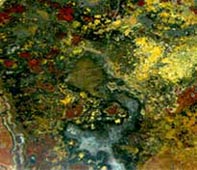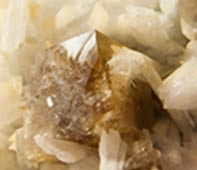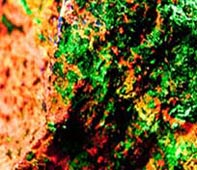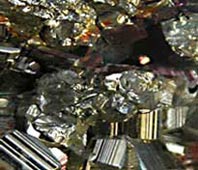




How Old is the Earth? (Part II of II)
by Harold H. Lundberg
From: The Pick and Dop Stick, 4/2012
9th Place — 2013 MWF Original AduIt Articles
Moving on to the Christian era. Almost from the beginning, clergy were trying to establish a firm date for the Creation. It was needed so they could calculate "the second coming of Christ and the end of the world". They worked mostly by counting generations in Geneses.
Up until the 9th century time was not calculated from the birth of Christ, but from the origin of the world. Before that, Christianity counted years by the reign of the Roman emperor, or according to the biblically-calculated time since Adam, or Anno Mundi (AM). The AM count was based upon biblical passage. At the time it was believed that the world was formed on Sept. 1, 5509 BC. Numbering years according to our modern system was suggested by the monk Dionysius Exiguus in the 6th century and more commonly adopted in the 9th century.
It would be almost 1800 years before someone came up with another way to do it, and true scientific investigation was applied to the problem. The modern year is 365 days 5 hours 48 minutes 46 seconds long (approximately) or 365.242199 days.
Theophilus (? to 190 AD), a bishop of Antioch, worked out the date 5529 BC. Julius Africanus (? - 232 AD) worked out an interval of 6000 years between the creation and the Last Judgment. He noted that 5,723 years had already passes, and therefore the end of time was predicted to be 498 AD. There was much disappointment when Christ didn't show up and the world didn't end. Lots of different people worked on the question, all by examining scripture and then augmenting their research with secular supporting sources.
James Ussher, Anglican Primate of All Ireland, was a classical and biblical scholar who undertook a careful, critical synthesis of historical Biblical, Middle Eastern and Mediterranean documents, Roman history and ancient calendars. In 1650 he published his "Annals of the World," in which he concluded that Earth was created on Sunday, Oct. 23, 4004 B.C., a date that is not too distant from the earliest known writing in Sumerian.
The naturalist Mikhail Lomonosov, regarded as the founder of Russian science, suggested in the mid-18th Century that the Earth had been created separately from the rest of the universe, several hundred thousand years before.
Edmund Halley, of cometary fame, suggested a way in 1715 to make a physical estimate of Earth's age. He reasoned that rivers are continually washing small amounts of dissolved salts into the oceans, so over time the oceans should get more salty. However, he made no estimates due to lack of data. In 1799, John Joly, an Irish geologist, used Halley's method to estimate Earth's age to be between 80 million and 90 million years old. The method doesn't work with any accuracy. Joly was unaware of the various ways that salts are naturally removed from the oceans, part of the natural recycling processes that keep salinity constant. Besides, the chemistry of ocean salinity is far too complex for this to be a viable way to estimate the age of Earth or the oceans.
George-Louis Leclerc Buffon, a French naturalist and the most prestigious scientist of his day, published "Epochs of Nature" (1778), in which he estimated the time it would take for a molten Earth to cool to its present state. He arrived at an age of about 75,000 years after conducting experiments with heated iron spheres and scaling their cooling rates to an Earth-size mass.
James Hutton (1726-1797), a Scottish geologist, is considered to be the founder of modern geology. In the rocks of Scotland, Hutton found fingers of granite (intrusions) reaching well into sedimentary rocks and saw this as evidence of subterranean fire and heat. He also found neatly deposited layers of sedimentary rocks overlaying other sedimentary rock layers that were almost vertical. The lower layers of rock, he concluded, must have been deposited eons before, and then later upturned. Based on these findings, Hutton was the first to describe the vast expanses of time in Earth's history.
These finding were reported in 1785 in a paper entitled Theory of the Earth, often cited as one of the seminal foundations of geological theory. Based on rates of sedimentation and the lack of deterioration of Hadrian's wall, among other things, Hutton envisioned "no vestige of a beginning, no prospect of an end" and initiated his concept of "deep time," an age for Earth that was far, far older than human history, a concept that was not envisioned by any previous investigators since the Greeks.
In 1854, the German physicist Hermann von Helmholtz calculated that it would take 100 million years for the sun to condense down to its current diameter and brightness from the nebula of gas and dust from which it was born. He assumed that the sun was only glowing from the heat of its gravitational contraction. The process of nuclear fusion that powers the sun was not yet known or suspected.
In 1862, William Thomson, aka Lord Kelvin, calculated that it would have taken 98 million years to for Earth to cool from molten to present temperature. Kelvin was unaware of the heat that radioactivity generates within Earth's interior because Becquerel did not discover this phenomena until 1896.
No one really conceived of an age in the billions of years until Ernest Rutherford, a pioneer in the study of radioactivity, suggested in 1904 that alpha particles released by radioactive decay could be trapped in a rocky material as helium atoms, and could thus be used to estimate the time since the rock's formation.
Radioactivity works as a clock because certain isotopes are unstable and break down or decay. When they decay each radioactive isotope emits nuclear particles of a particular kind with a characteristic speed. By measuring the types of particles given off and counting their numbers, scientists can determine the amounts of various radioactive atoms in a sample of rock. Each decaying atom leaves behind a unique "daughter" atom. Many daughter isotopes are also radioactive and can also be useful in the dating process. Each radioactive isotope decays at a fixed rate that does not depend on the physical or chemical state of the atom. After a century of testing, no physical process has ever been discovered that changes the rate of decay for a given isotope. The term "half-life" refers to the amount of time required for one-half of a collection of particular "parent" atoms to decay to the "daughter" atoms. Because each isotope decays into a particular type of daughter atom at a unique rate, it is possible to determine the number of half-lives that have elapsed by comparing the relative amounts of parent and daughter in a sample of rock.
Events such as melting or baking at high temperatures might reset the clock by allowing some or all of the parent or daughter to escape, so geologists are aware that the radiometric dating gives the age of the most recent event in the rock's history. There is a certain amount of uncertainty in any single measurement, so reliable measurements use multiple parent-daughter pairs. The ages determined from different sets of parent-daughter pairs plot on a straight line on a graph, indicating a correspondence of ages and a level of confidence that the ages are correct. The oldest rocks found on Earth are nearly 4 billion years old. This does not represent the age of Earth because these rocks are metamorphic, meaning that they were created from pre-existing rocks that must be older still.
The final piece in the greatest age puzzle comes from the ages of meteorites and moon rocks. Our best understanding of the formation of the solar system suggests that all of the planets and other objects formed around the same time and from the same kind of materials. The average age of moon rocks and meteorites is 4.6 billion years, plus or minus 100 million years, as determined by hundreds of measurements using the full range of radioactive isotopes with suitably long half-lives.
I have left out references to the modern Creationists and "Intelligent Design". Their view is essentially a rehash of the 6000 year age proposed by Theophilus, Julius Africanus and James Ussher, brought up to date.
For permission to reprint this article, contact us at info@chicagorocks.org.
